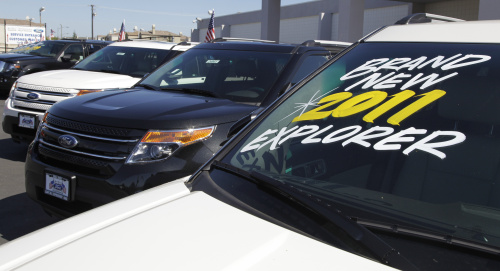WASHINGTON (AP) ― Consumers spent less on autos, clothing and furniture to leave retail sales unchanged in August.
The lack of growth suggests households became more cautious during wild stock market fluctuations and increased fears about the economy.
The Commerce Department also said Wednesday that retail sales were slightly weaker in July than first thought. They rose just 0.3 percent, down from the initial reading of 0.5 percent.
Auto sales fell 0.3 percent in August. Sales at clothing stores declined 0.7 percent. Gasoline sales rose.
Analysts said Hurricane Irene likely disrupted sales in late August along most of the East Coast.
Stocks were trading higher when the market opened but fell later on in morning trading. The Dow Jones industrial average dropped more than 60 points.
Consumer spending is important because it accounts for 70 percent of U.S. economic activity.
The overall economy expanded at an annual rate of just 0.7 percent in the first six months of this year, the slowest growth since the recession ended two years ago. Employers added no net jobs in August, and the unemployment rate stayed at 9.1 percent.
Paul Dales, a senior U.S. economist for Capital Economics, said he expects a small pickup in growth in the July-September quarter, despite the softening in retail sales.
“That said, with jobs growth flat the prospect of any further acceleration in the fourth quarter is slim,” Dales said.
A separate report showed inflation at the wholesale level was not a problem in August. The Labor Department said its Producer Price Index, which measures price changes before they reach the consumer, was unchanged in August after a 0.2 percent rise in July. A drop in energy prices in August offset higher food costs.
The flat reading for retail sales was a surprise given private reports from retailers and auto dealers that suggested a brighter picture in August.
Major automakers reported healthy sales increases in August, largely because dealers introduced new models and offered cheaper financing. The nation’s major retailers reported solid results from the all-important back-to-school shopping.
 |
Ford Explorers are displayed at a car dealership in San Jose, California. (AP-Yonhap News) |
Unlike the industry figures which compare the current month to a year ago, the government’s figures compare the current month to the previous month.
The government report showed sales at department stores fell 0.3 percent and a broader category of general merchandise stores, which includes big retailers such as Wal-Mart and Target, showed a slight 0.1 percent gain. The 0.7 percent fall in sales at specialty clothing stores followed a 0.3 percent decline in July.
High unemployment and a spike in gasoline prices earlier this year had forced many consumers to be more cautious.
Consumers are feeling less confident after a rocky summer. Lawmakers fought over raising the federal borrowing limit, Standard & Poor’s downgraded long-term U.S. debt, and stocks have fluctuated wildly after plunging in late-July and early August.
The Federal Reserve said last month that it expects the economy will stay weak for the next two years. As a result, the Fed said it planned to keep interest rates very low until at least mid-2013, assuming the economy remained weak.
Fed officials will meet next week to consider other steps to support to the economy.




![[Herald Interview] 'Trump will use tariffs as first line of defense for American manufacturing'](http://res.heraldm.com/phpwas/restmb_idxmake.php?idx=644&simg=/content/image/2024/11/26/20241126050017_0.jpg)

![[Health and care] Getting cancer young: Why cancer isn’t just an older person’s battle](http://res.heraldm.com/phpwas/restmb_idxmake.php?idx=644&simg=/content/image/2024/11/26/20241126050043_0.jpg)

